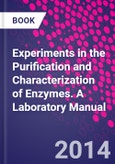Experiments in the Purification and Characterization of Enzymes: A Laboratory Manual provides students with a working knowledge of the fundamental and advanced techniques of experimental biochemistry. Included are instructions and experiments that involve purification and characterization of enzymes from various source materials, giving students excellent experience in kinetics analysis and data analysis. Additionally, this lab manual covers how to evaluate and effectively use scientific data. By focusing on the relationship between structure and function in enzymes, Experiments in the Purification and Characterization of Enzymes: A Laboratory Manual provides a strong research foundation for students enrolled in a biochemistry lab course by outlining how to evaluate and effectively use scientific data in addition to offering students a more hands-on approach with exercises that encourage them to think deeply about the content and to design their own experiments. Instructors will find this book useful because the modular nature of the lab exercises allows them to apply the exercises to any set of proteins and incorporate the exercises into their courses as they see fit, allowing for greater flexibility in the use of the material.
Written in a logical, easy-to-understand manner, Experiments in the Purification and Characterization of Enzymes: A Laboratory Manual is an indispensable resource for both students and instructors in the fields of biochemistry, molecular biology, chemistry, pharmaceutical chemistry, and related molecular life sciences such as cell biology, neurosciences, and genetics.
Please Note: This is an On Demand product, delivery may take up to 11 working days after payment has been received.
Table of Contents
Safety Guidelines for Biochemistry Laboratories General Guidelines for Handling Solutions of Protein Maintaining a Laboratory Notebook Introduction to Enzymes Catalyzing Oxidation-Reductions with the Coenzyme NAD(P) Computational Techniques for Biochemistry Software for Analysis of Data Computational Methods and Bioinformatics for Studying the Structure and Function of Proteins Background: Software and Databases; 1. Retrieve Entries from a Database and Compare Sequences of Amino Acids; 2. Compare the Tertiary Structures of Polypeptides Section 1: FNR; Purification and Characterization of Ferredoxin-NADP+ Reductase from Chloroplasts of S. oleracea 1. Preparation of a Lysate of Chloroplasts and Sequestration of Proteins by an Anion-exchange Solid Phase; 2. Elution of Proteins from the Anion-exchange Solid Phase and Assays for the Concentration of Total Protein and FNR Activity; 3. Isolation of FNR by Adsorption and Elution 4. Electrophoresis of Proteins from the Chloroplasts and Purified FNR on Gels of Polyacrylamide Cast in Solutions of Dodecyl Sulfate; 5. Kinetic Assay for the Km of FNR for NADPH; 6. Estimation of the Size and Quaternary Structure of Native FNR Using Chromatography by Molecular Exclusion; 7. Detection of FNR in Extracts from Chloroplasts of Spinach by Immunoblotting Section 2: LuxG; Purification and Characterization of a Recombinant FMN Reductase from P. leiognathi 1. Expression of LuxG-hexahistidine in E. coli and Its Release from the Cells by Lysis; 2. Affinity Adsorption of LuxG-hexahistidine to a Solid Phase to which Ni2+ is Chelated; 3. Electrophoresis of the Polypeptides in the Lysate and Purified LuxG-hexahistidine; 4. Assay for the Flavin Reductase Activity of LuxG-hexahistidine; 5. Determination of the Michaelis Constant of LuxG-hexahistidine for NADH; 6. Determination of the Molar Concentration of LuxG-hexahistidine Spectrophotometrically Section 3: LDH; Purification and Characterization of Bovine LDH 1. Preparation of the Isoenzymes of LDH from Extracts of Various Tissues; 2. Spectrophotometric Assay of the Activity of Bovine LDH; 3. Separation and Visualization of the Isoenzymes of LDH by Electrophoresis on Cellulose Acetate; 4. Fractionation of Proteins in Bovine Heart by Precipitation with Sulfate; 5. Purification of LDH from Heart by Affinity Adsorption and Elution; 6. Concentration of Protein by the Bradford Stain and Absorbance at 280 nm; 7. Electrophoresis of Native Proteins from Bovine Heart and Purified LDH on a Gel of Polyacrylamide; 8. Electrophoresis of Unfolded Polypeptides from Bovine Heart and Purified LDH Saturated with Dodecyl Sulfate; 9. Determination of the Michaelis Constant, KmNADH, of the Isoenzymes of LDH for NADH; 10. Chromatography by Molecular Exclusion to Evaluate the Quaternary Structure of LDH; 11. Detection of LDH in Extracts of Bovine Tissue by Immunoblotting Section 4: Experimental Design; 1. Association of FNR with the Membranes of the Thylakoids in the Chloroplasts from Spinach; 2. Search for Multiple Flavin Reductases in P. leiognathi; 3. Assay for LDH Activity Specific to (R)-lactate in Bovine Mitochondria Appendices I. Measurement of Absorbance with Multiwell Plates and an Automated Plate Reader; II. Operation of the Spectronic 20D+ Spectrophotometer








